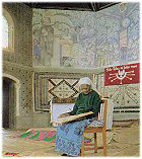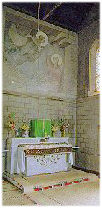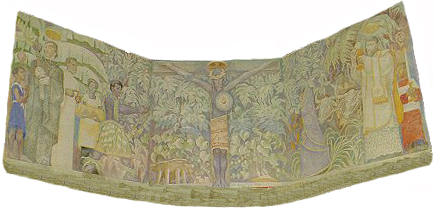| The Church of Saint Francis Xavier
Astride a village green and unable to be seen from the road is a stone church of distinctly European design that looks a little worse for wear form the outside but houses one of Fiji's most surprising modern treasures. The Church of Saint Francis Xavier at Navuibutu was officially dedicated in 1917 after a decision was made to shift from the original mission site in 1895. This followed the arrival of the Marist missionaries to the area in 1889, and the establishment of a Catholic presence in While the church looks traditionally European from the outside, the use of mats instead of pews for parishioners gives it a Fijian village flavour. What makes the Navuibutu church so unusual are the murals, a series of frescos originally commissioned by one time chaplain to Austria's famous Von Trapp family, Monsignor Fanz Wasner. The murals, done in true fresco style by painting on top of wet plaster, were created by Frenchman Jean Chalot, assisted by his wife Zohman and son Martin, between October 1962 and January 1963. The wall behind the main alter has been formed into three panels of equal size.
The central panel portrays a dark skinned crucified Christ clothed in a loin cloth of local bark, masi. On each side of the triptych are the two major races in Fiji- Fijian and Indian- converging on the central figure of Christ. Each race has its traditional gifts and symbols. On the Fijian side are pictured a kava bowl and tabua (sacred whales tooth). Also pictured is the patron saint of the South Pacific, Saint Peter Channel, holding a war club- the instrument of his own death. The Fijian priest pictured is now the Arch Bishop of the Diocese, the Most Reverend Petero Mataca. The left panel depicts a sari-clad lady offering a garland of flowers. Behind her is an Indian farmer with yoked oxen ploughing a field of sugar cane. An Indian alter boy and the patron saint of India, and of the Navuibutu Church, Saint Francis Xavier complete the mural. There are two similar murals on the side walls, one showing Christ as a young child helping Joseph the carpenter. Over the right alter is a mural showing the Annunciation, with Mary engaged in a typical feminine village occupation, weaving a mat of pandanus leaves. The Church of Saint Francis Xavier is no museum, however, but a living church serving the needs of around 2000 Catholics from the surrounding province. |
 High on the hill overlooking the dusty Kings Road on the north-western side of Fiji's main island of Viti Levu is a theologian's enigma.
High on the hill overlooking the dusty Kings Road on the north-western side of Fiji's main island of Viti Levu is a theologian's enigma. the Ra province in 1870.
the Ra province in 1870.